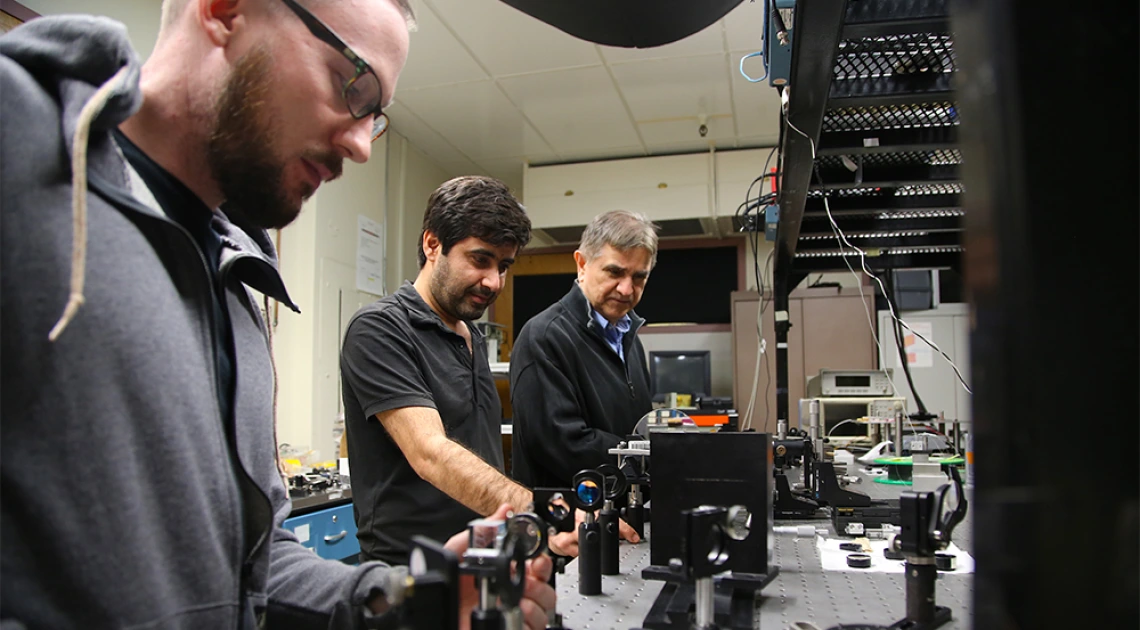UA Startup to Bring Holographic Video Glasses Into View

TUCSON, Ariz. – Researchers at the University of Arizona College of Optical Sciences have developed a new breed of augmented reality display that is capturing high-tech imaginations. Inventor and professor Nasser Peyghambarian, Ph.D., has been working on video holograms for over two decades.
Today’s popular virtual reality technology uses goggles that completely block out the outside world. In contrast, augmented reality creates an environment that layers computer-generated perceptual information like images, sounds or touch over what we experience in the real world.
While companies like Microsoft are commercializing devices such as Hololens 2 that enhance virtual and augmented reality, the inventions that EARDG Photonics Inc. has licensed represent a different technological approach; the new technology will provide augmented reality wearable glasses that allow users to combine the real world around them and an augmented holographic video display with superior performance.
Peyghambarian is leading the company along with Lloyd LaComb, Ph.D., also a UA optics research professor and experienced industry leader. The two have a history of successful collaborations; together they developed TIPD, another company advancing 3-D holographic displays. Working with Tech Launch Arizona, the UA office that commercializes inventions stemming from research, EARDG has licensed the technology, along with associated technology from TIPD, to develop it and bring it to the marketplace.
“While it is important to conduct state-of-the-art research at universities and publish in high-impact scientific journals,” said Peyghambarian, “it is as important to have a consistent effort on translating innovative research out into the real world through technology transfer and creation of startup companies so that it not only creates jobs but also improves lives.”
A dedicated educator, mentor and National Academy of Inventors Fellow, he also notes that such inventions and startup companies represent excellent opportunities for students. “Those that work on such technologies with us are highly sought after as they gain experience in solving real-world problems,” he said.
EARDG is leveraging three specific inventions that came out of Peyghambarian’s holography research: novel photorefractive polymers, a system for recording holograms, and a means of producing 3-D telepresence. By combining the three inventions with new approaches, EARDG plans to develop its flagship enhanced augmented reality display glasses.
According to Tech Launch Arizona’s Amy Phillips, senior licensing manager for the College of Optical Sciences, the licensed technology allows for the writing of holograms into a specialized material that has a very fast refresh rate. While standard holographic images are written with lasers into media with permanent or very slow decay rates, the new technology allows for 3-D images to be written and refreshed at 30 per second, a rate that the brain processes as true video.
“The challenge was figuring out how to record the holograms,” says Phillips, who has helped Peyghambarian define and protect numerous inventions over the years. “They had to develop a material that holds the image long enough to see, but then extinguishes it fast enough so you can rapidly create the next one.”
With EARDG taking the technology forward, true augmented reality video appears to be coming into focus, even more so now that the startup has secured its first investment from UAVenture Capital, a fund created by UA alumnus and entrepreneur Fletcher McCusker and his partner Michael Deitch to advance new companies with close connections to the UA.
“The formation of EARDG, based on a combination of intellectual property from the University of Arizona and earlier UA startup TIPD, is further evidence of the impact UA is having on the innovation ecosystem,” said Doug Hockstad, assistant vice president of Tech Launch Arizona. “We’re very excited about this development and the potential impact of the technology.”

